Native Son: April 2014
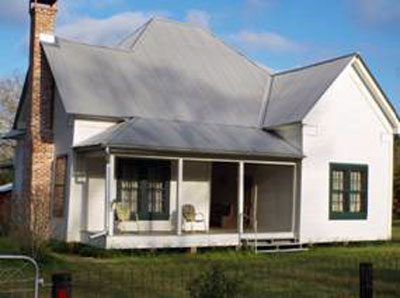
One of Greg Grant’s time-honored houses in Arcadia, Texas. Photos by Steven Chamblee.
by Steven Chamblee
Arcadia and Mexican Plum
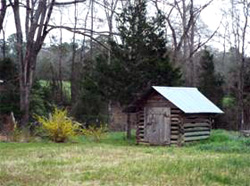
A simple corn crib creates a bucolic scene.
Got an invite to visit East Texas in early spring. Sounds like heaven to me, so I sneak out of work early, make good time on the road, and pull into Arcadia just before dark. This tiny town is the home to wonderful old houses, old pine trees, old memories, and good old Texas horticulture guru Greg Grant. While Greg is not actually that old in body, he is indeed an old spirit who reveres family, traditions, and a simpler way of life.
He tosses me into a quaint old house to sleep off the drive, and says he’ll be back in the morning to show me around a bit. I look forward to having him pull back the curtain of time to give me a peek at what life looks like when whatever’s on TV isn’t nearly as good as whatever’s out any window. And while that sounds all sweet and nostalgic, I have heard tell that Greg’s circadian rhythm is also set to the year 1913, and he can be excessively perky first thing in the morning. Thank the Lord there is a modern day coffee maker in the kitchen; I’m not quite up for an old crank coffee grinder and tiny chunks of coffee in my teeth.
Sure enough, he’s chipper as a chipmunk at 6 a.m., knocking on the door and saying stuff like, “You’ve already missed the best part of the day!” Now I’m looking around for that old crank coffee grinder and wondering how I’m going to fit him into it.

Greg is plenty chipper first thing in the morning.
Forty minutes later, I’m coffee’d up and perking. We hop into his truck and I say I am a little surprised that he isn’t driving a 1952 Chevy 3100 five-window, split windshield pick-up with that quirky exterior sun shade. His forlorn expression tells me that he used to drive something like that and misses it, so I quickly switch the topic to chickens … everybody likes to talk chickens. Within 20 minutes, I see five old family houses, some feral hog damage, a newly-replanted pine forest, two bald cypress mini-bogs, bottle trees, several thousand naturalized narcissus bulbs along the roadside … and about two dozen pretty little laying hens.

Twin bottle trees and a few of the laying hens.
Inside the last house, Greg plays piano while I poke around the place, admiring antique furniture, funny little curios, a collection of family heirloom blankets, and books … lots of books. Greg is that one guy who has actually read all of the books in his house, and his working knowledge of history, culture, problem-solving, and, oh yeah, horticulture is simply astounding. If I were half as smart as Greg, I’d be roaming the earth in search of some sort of idyllic place where I could realize the big secret of life and find my place in it. I think Greg has found his.

Top photo: Each treasured family quilt tells a story. Bottom left photo: Greg plays piano. Bottom right photo: One of many bookshelves around Greg’s house…note the flat iron bookends.
Half an hour of pastoral meadows and managed pine forests later, we pull onto the campus of Stephen F. Austin State University in Nacogdoches. I tell Greg I’ve always wanted to carve a cactus with him, so we get right to work. While I’m pretty proud of my lopsided heart design, Greg one-ups me with a flat-topped man eating a cookie … or that’s what it looks like to me.
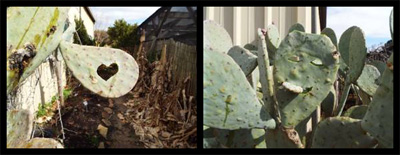
We bump into some other SFA brainiacs, Dawn Stover and Dave Creech, and it takes about eight photos before Greg and Dave stop their “bad outlaw and grumpy sheriff” routine to pose for a respectable picture.
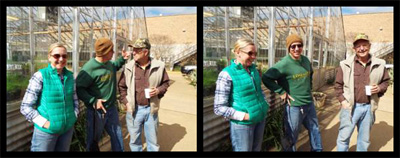
Dawn Stover, Greg Grant and David Creech
Dave Creech shows me around the greenhouses before taking me out to a research plot of Mexican sugar maple (Acer skutchii). Endangered in its native habitat of montane cloud forests in Mexico and Guatemala, this fast-growing, sun/alkaline-soil-tolerant maple shows excellent promise for Texas gardens. Interesting how something can fade away in its own original place, then thrive in another.

Dr. Creech in the SFA research plot of Mexican sugar maples. Fresh spring growth on a test tree.
All too soon, my SFA adventure is over, and I’m heading home. A roadside tree in full bloom beckons for me to stop and visit for a few moments … who could resist? Mexican plum (Prunus mexicana) is a small, deciduous, native tree that flowers about the same time as redbuds, making them excellent garden companions. The cream-colored blossoms (which some folks say smell a bit like warm tortillas) appear before the leaves and attract copious numbers of honeybees, as well as a few other insect pollinators. The dull green, heavily-veined leaves always have a curious droop to them, as if the plant is in need of water. By fall, the nickel-sized fruit begin falling from the tree before they ripen … and, by my observation, never actually seem to fully ripen.
I’ve always snickered a bit at the common name, as Mexican plum’s native range is primarily from Texas to Missouri and east to Alabama, and only a few small pockets in Mexico. But maybe it, like the Mexican sugar maple (and Greg Grant), has found life in East Texas is the place to be.
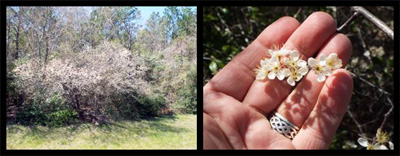
Mexican plums in full bloom, plus a closeup of the fragrant blossoms.
P.S. Thirteen days later, I’m at The Dallas Arboretum to teach a class on Texas-Tough Plants. I am fully aware of the yin-yang of the moment: I’m inside preaching the gospel of conservative plant choices that will survive through heat and drought … while just outside the window, the Dallas Blooms spring event is in full swing, which looks a bit like God himself baked a wedding cake and decorated it with every color of the rainbow. Cherry trees billow and weep with delicate white blossoms, forsythias erupt from the ground and spew yellow like hundreds of floral fountains, and redbud trees dance with delight in their pink party dresses.

A late-arriving spring has prolonged the spectacle of Dallas Blooms at the Dallas Arboretum.
But the real stars of the show are the tulips. These floral lollipops, dipped in the most exquisite and sometimes impossibly delicate of colors, spill across the gardens like Monet, van Gogh, and Matisse got together over margaritas, wound up stealing a Sherwin-Williams truck, and painted everything in sight. What begins as charming quickly grows into beautiful … then keeps growing. The beautiful burgeons into gorgeous; gorgeous into amazing; amazing into fantastic; fantastic into a dream state, from which there is no escape. The sheer number of flowers quickly overwhelms the senses, and you feel like you’ve just stepped off a roller coaster. Visit right away … with temperatures in the low 80s, these beauties won’t last long!

Steven adds these notes:
Come on out this weekend (April 5 & 6) for Chandor Gardens’ annual Spring Fling! Music, food, flowers, and fun … all for only $1. Go to www.chandorgardens.com for details. Just take I-20 west to exit 409, hang a right, go 2.1 miles and hang a left on Lee Avenue. Head straight 12 blocks and you’re driving in the gates. Call 817-361-1700 for more information.
I can always use another road trip! Let me know if you’d like me to come out and speak to your group sometime. I’m low-maintenance, flexible, and you know I like to go just about anywhere. No city too big; no town too small. Just send me an e-mail at stevenchamblee@yahoo.com and we’ll work something out.

